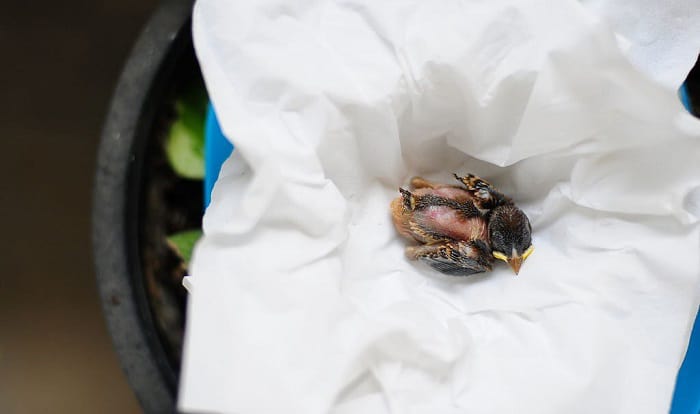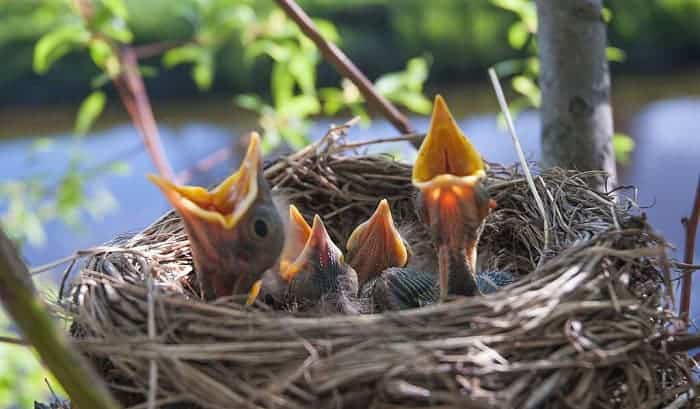There are approximately 10,000 passerine species in the world. Some breeds are in danger of getting extinct, while others are thriving still. The sad truth is, many young avians die everyday due to injuries.
The nestlings and fledglings are the most vulnerable. Their parents care for them, but humans can help too. So if you’re wondering how to tell if a baby bird is dying, look at its physical aspects. There would be obvious signs of injury such as blood, fractured legs, and weakness.
Table of Contents
- Techniques to Determine if the Baby Birds Are Near Death
- Tools Needed To Check The Status Of A Baby Bird
- Detailed Steps On How To Check If The baby Bird Is Dying
- Step 1: Identity a nestling from a fledgling
- Step 2: Look for physical signs of injury
- Step 3: Look for other characteristics of the feathers
- Step 4: Listen to the breathing pattern
- Step 5: Check for discharges
- Helpful Tips to Save a Dying Baby Bird
- Conclusion
Techniques to Determine if the Baby Birds Are Near Death
Tools Needed To Check The Status Of A Baby Bird
The only tool needed to determine if the baby bird is dying or not is a pair of gloves. You also need the contact information of a local animal rehabilitator or vet.
Detailed Steps On How To Check If The baby Bird Is Dying
Unfortunately, finding a dying baby avian is a common occurrence. If a baby bird is dying, you can either rescue it, comfort it until it loses its life, or call a local animal rehabilitator.
But before you do any rescuing, it’s imperative that you know how to tell if the baby passerine is indeed dying. By following the steps below, you’ll learn what to look for.
Step 1: Identity a nestling from a fledgling
Young birds can get sick due to starvation, falling off the nest, or a flight failure that ends with a young bird laying on its back. The weather can also play a huge role in the peril of baby avians.
Whatever the reason is for the chicks to be sick or wounded, it’s ideal to determine if the baby bird is a nestling or a fledgling.
- Nestlings – These are newly hatched birds with very few feathers, shut eyes, and loud chirping sound. Nestlings are often hurt when they fall from their nests due to a strong wind. When found, the small baby passerine is usually under a tree where their nest is located, so it’s best to return the baby bird.
- Fledglings – These are young chicks that are capable of hopping or flying. They’re ready to be on their own, but accidents can happen while they venture out to the world.
When found, they’re most likely away from their nests. You can either search for their nest, or build a makeshift one for them.
Step 2: Look for physical signs of injury
Once you have identified the kind of baby bird you’ve found, it’s time to look for physical signs a bird is dying. Check if there is blood on the feather. Since the young passerine is still tiny, there may be a small amount of blood only, so be keen in your search.
There are also other obvious signs of injuries such as:
- Dirt on the baby bird’s feathers and other body parts
- Bloated eyes
- Broken plumage and broken legs
- Ptiloerection in warm weather
- Dislodged feathers
- Dislocated limbs
If you find a fledgling and see that it has trouble walking, hopping or is limping, then that’s a sure sign of injury.
Any of the signs of injury can lead to the death of the baby bird if left untreated. In many cases, young avians cannot be saved, especially if they’ve been left on their own for a long time.
Step 3: Look for other characteristics of the feathers
Keep in mind that nestlings barely have feathers. So when you see that they have scarcity in plumage, it doesn’t mean that a nestling is dying.
However, in the case of fledglings, the absence or scantiness of feathers is a symptom of illness or a close call of death.
In both nestlings and fledglings, check if their skin is unusually scaly. In many cases, skin dryness in young avians is caused by an infection from parasites. This disease plucks the life from their feathers, and leaves them appearing washed out.
Baby birds can also acquire cysts, and you can only tell their presence if you touch their feathers. Of course, in searching for lumps, you need to wear gloves.
In any or both of the scenarios, there is nothing you can do for the chicks. But you can call a local animal rehabilitator or bring the young passerine to a vet.
Moreover, if you see that the feathers of the baby bird are shaking continuously, then that means that the chick has a high fever. In this situation, you can help the baby bird find a safe place to stay and heal.
Step 4: Listen to the breathing pattern
A baby bird breathing fast is often a sign of a respiratory problem. In order to check for the breathing pattern, you need to carry the weakened young bird on your palm and listen to it draw breath.
The obvious indications of breathing difficulty that may lead to the death of the baby birds are:
- Wheezing sound
- Heavy panting
- Open bill while breathing
- Clicking sounds
- Labored breathing
Also, watch out for the attempts of the baby passerines to move their nape, because this is a sign that they’re trying to let air in. Another indication of gasping for air is constant, albeit weak tail motions.
Young birds are prone to respiratory illness. If they are not seen by a vet, they could die from lack of air in their lungs.
Step 5: Check for discharges
A baby bird breathing heavy is an indication of sickness, but aside from that, discharges are also a sure sign. Look closer and check if the nostrils, beak, ears, and eyes of the baby bird have discharges. If there are discharges, contact a professional to deal with the baby avian.
The disease can transfer to you, which is absolutely unfortunate. That’s why in handling a sick or wounded chick, you need to always wear gloves.
More importantly, avoid getting the discharges onto your skin or clothes. You may even spread the illness to other birds if they come in contact with you. So prioritize safety and health, even while helping a baby bird.
Helpful Tips to Save a Dying Baby Bird
Wounded baby birds are helpless, especially when their parents are not around. And as a bird enthusiast, you simply don’t have the heart to leave an injured chick alone. So to do the right thing, here are some helpful tips on how you can save a passerine’s young life:
- Put on a clean pair of gloves and lift the wounded baby bird from where it is lying. Then take the chick to a safe place.
- Find a cardboard box, then place tissues or a used towel inside to create a makeshift bed for the young avian.
- Place the baby passerine inside the interim nest carefully. You can also add a heat pad if the weather is cold.
- Leave the surrogate nest at a tree or in your backyard.
- This may sound surprising, but it’s best not to feed injured birds. You may give them the wrong food, or the bird may not be strong enough to digest it and become sicker.
- Wait for the parents to find the baby bird, or you can call a vet or local rehabilitator.
Saving a young bird’s life is rewarding, and it feels good. But if the baby passerine did not make it, sometimes, you may be able to bury it underground. If you’re unsure what to do, look up the laws of your local government before doing anything with the bird.
Conclusion
A dying baby bird is not a pretty sight. Thankfully, not all young passerines that are injured will end up dying. Sometimes, they can be saved. You just need to learn how to tell if a baby bird is dying and what to do.
Look for physical signs of distress, and determine if you’re rescuing a nestling or a fledgling. And then follow the helpful suggestions on how to save a baby avian.
We hope you gained new insights from this post. Kindly take the time to share this to your friends. And leave us your thoughts and comments.

George and I became friends after a birdwatching trip with our new group. And we have been enjoying every adventure together. When he told me the idea of establishing a site that shares our experiences and fun, I immediately agreed. After trials and errors, here we have Thayerbirding.
















